Buying a second-hand Jimny in Australia
I’m not aiming to provide an absolutely comprehensive list of things I’d look at with a used Jimny, but I want to try to educate people on some considerations, and also some of the differences between the cars. Even just so people have an understanding the differences between the models, so they don’t pay auto GLX pricing for a well beaten up lite: a lower specification and cheaper car.
Sections
- Checklist
- What should I pay?
- Differences between models and years
- Things to look for
- Modified? Things to look for with common mods
Checklist
This will continue to evolve as a checklist, but I wanted to provide a 2-page PDF form that you can print or fill out and save on your phone or other device. Some of these fields provide both a checkbox and a field for notes. You’ll want to read this whole page to understand some of the things you’re looking for.
What should I pay?
This is a super complicated question; I was going to try to answer it succinctly but it’s hard… so I wrote an entire article analysing Jimny prices as at the middle of 2024. It will eventually get out of date but some basic conclusions that will probably be robust are:
- Automatics are higher valued than manuals ($2000-$5000 more!)
- Automatic 3 door cars can be the highest priced (on average) on the used market, 5 doors do not quite seem to hold their value or move as quickly as 3 doors
- If it is around a year old or newer, you could still find yourself paying a little over retail due to lack of supply of cars (especially automatics)
- Lites are consistently about $1000-$1500 below a manual GLX car
- Modifications or colours probably don’t change the value hugely but might change how quickly a car is sold due to how attractive it is to buyers who want those modifications
Differences between models and years
Lite: September 2021 to today
- VIN commences JSAGJB74V (Japan made, JB74 model)
- Black door handles
- Steel wheels
- DRL in bumper but no fog light
- Halogen headlights
- Manual heater and A/C controls
- Basic infotainment system with bluetooth
- Plastic steering wheel
- No auxiliary power socket in rear
- Has cruise control, autonomous braking, 6 airbags (driver, passengers, full length curtain airbag per side, seat airbag per front seat)
GLX: November 2018 (Launched January 2019) to today
As per lite, with some variations
- Colour coded door handles
- Alloy wheels
- DRL and fog light in one unit in bumper
- LED headlights with self-levelling system and headlight washers
- Automatic climate control
- Infotainment system, either 7″ (Bosch – with internal GPS navigation) or 9″ (Directed – no internal GPS navigation)
- Electric folding mirrors from MY2020 onwards
XL: December 2023 to today
As per GLX, with some variations
- 5 doors not 3
- Longer and heavier than 3 door
- VIN commences MA3JJC74W
- LED headlights with manual levelling system controlled by driver and headlight washers
- Grille has chrome segments
- Infotainment system 9″ but not same as GLX 9″ screen
- Adaptive cruise control
- Slight differences in tyre choice (back to Bridgestone, but different to original Bridgestone H/Ts from 3 doors), but same tyre size as 3 door.
Model years (MY)
Launch cars are regarded as MY19 cars, even if they were built in the latter parts of 2018: There are some which are plated sometime in 2018. In September 2019 cars switched from a 6 month, 10,000 km service schedule to a 12 month, 15,000 km service schedule.
Note: 2018 built cars in Australia could well be the press demos and so might not have had the kindest early stage to their life. That said after nearly 6 years any potential problems will likely have already arisen from that use.
For MY20, cars received electric folding mirrors.
September 2021 saw the introduction of the lite as a model, which does not have electric folding mirrors.
MY22 cars have a revised head unit in the GLX models. This unit is known to be problematic, and in 2023 Suzuki reverted back to the 7″ Bosch infotainment system for GLX models.
MY23 saw a change from a flatter white to a pearl white. There is potentially also a tyre change for the factory tyres switching from Bridgestone to Dunlop, although this is not 100% consistent.
5 door cars were introduced from December 2023, although they are all regarded as MY24 onwards.
Things to check
Registration details, vehicle identity and finance owing
It’s always a good idea to record details about the seller separate to any paperwork you get with a car you buy. This saves you headaches in the long run, even if transfers are potentially done electronically now. At least get the name, phone number and address of a seller.
Before you even look at a car, you should do a vehicle registration lookup if it is registered. This varies state to state, as of June 2024 these are the links to the ways to do it for each state:
In addition to the rego, before you even look at it ask the seller for the VIN. This will let you do a check of the personal property security register, maintained by the Government. This is the old ‘REVS’ check for people who’ve been around for a while. There are lots of commercial providers who claim to be a REVS/PPSR check and that they provide more information, ultimately in Australia insurance writeoff photos etc are not mandatory. There is zero benefit in undertaking anything but the government provided check through the PPSR, the higher prices of the commercial providers is no guarantee of any additional or more useful information. A PPSR check will tell you if the car has secured finance over it, if the car has been written off and also if it is stolen.
For cars after 2023 you should also check them on the Register of Approved Vehicles (RAVS). This is patchy until quite recently so a lack of entry on RAVS is not (yet) diagnostic). As of end of 2022 compliance plates no longer needed to be fitted to a car, but instead compliance is tested against this Federal database of approved vehicles. There is still a requirement for a tamperproof identifier plate/sticker to be installed, but ‘compliance plates’ per se are no longer a thing. For very recent cars RAVS should give you compliance information including second-stage manufacturer applied upgrades such as a pre-rego GVM upgrade.
When you go to look at the car, you want to make sure that the VIN provided to you matches the compliance plate (pre 2023 cars) or other identity stickers (post 2023 cars) and also check that the engine number matches what came up in the PPSR search on the VIN. There are a couple of other locations of VINs on the car to check, such as on the chassis.
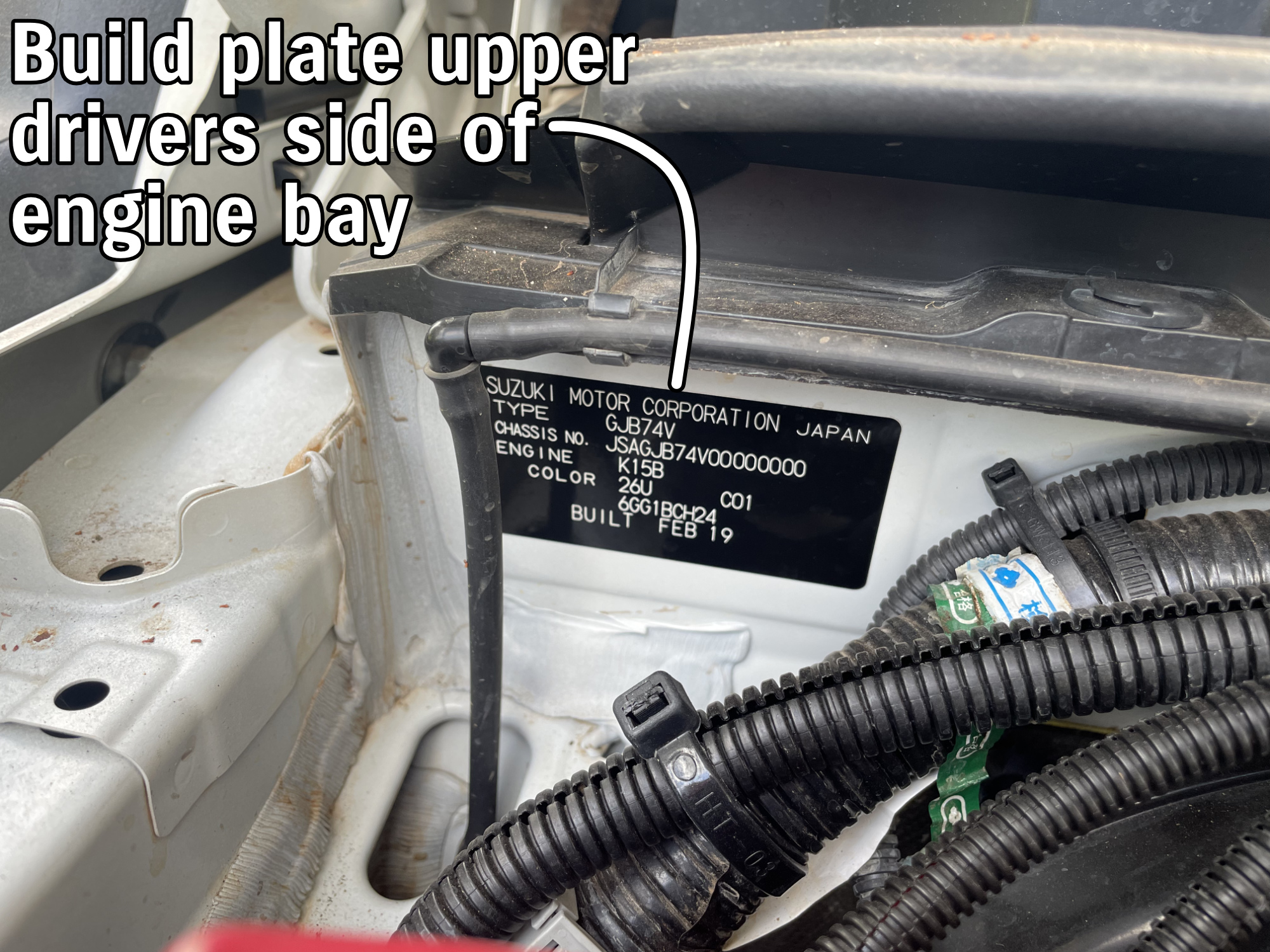
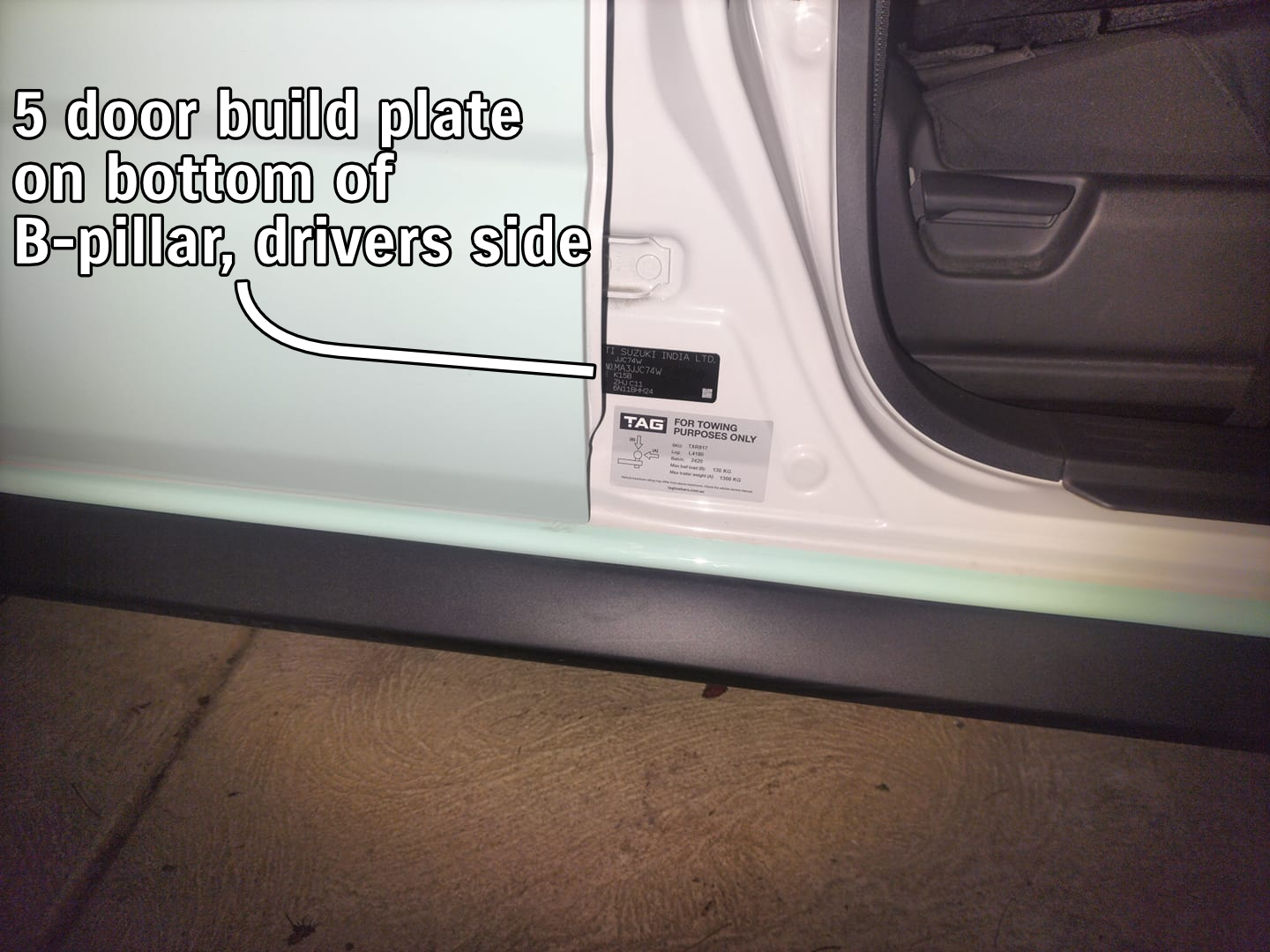
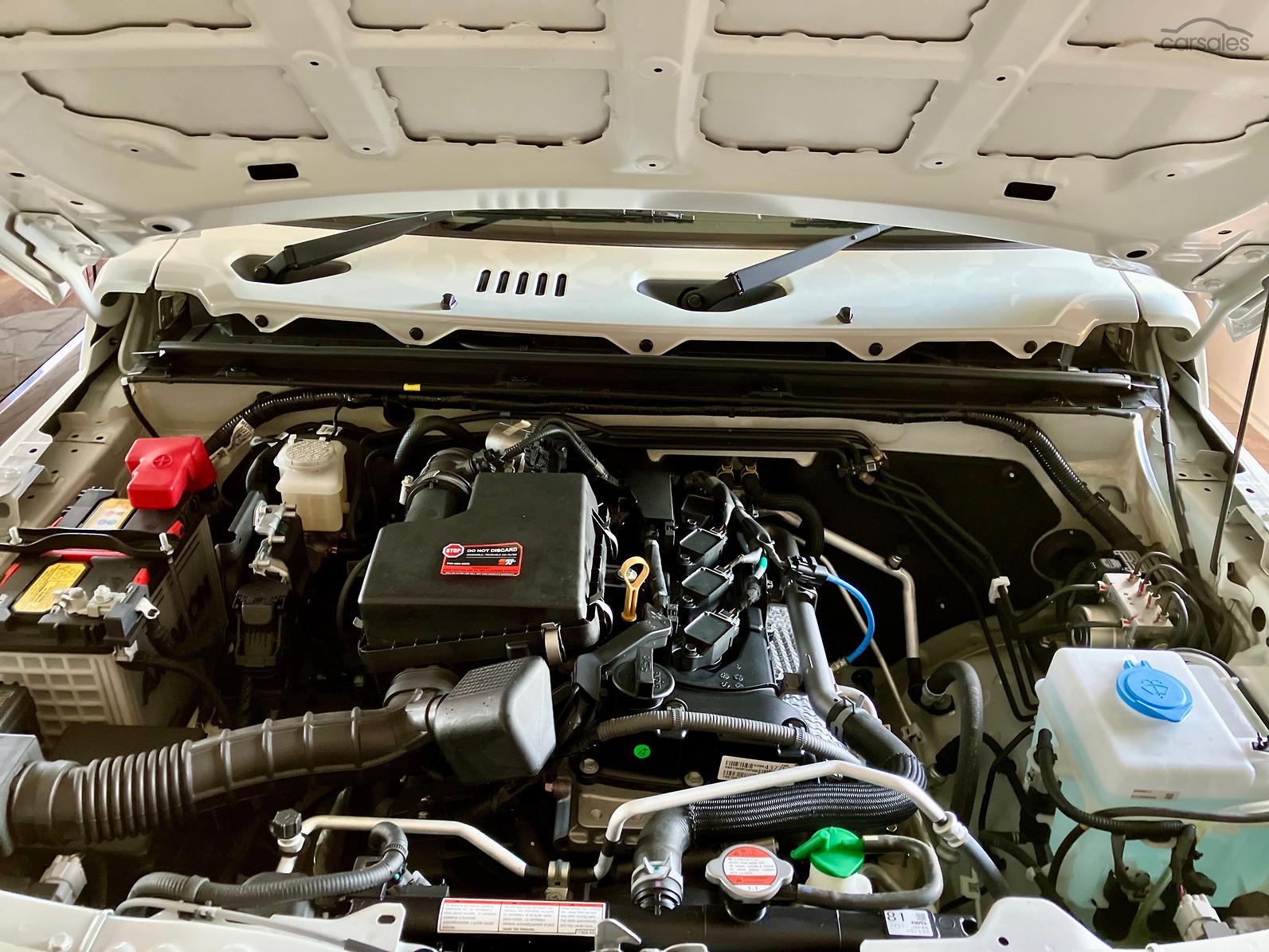
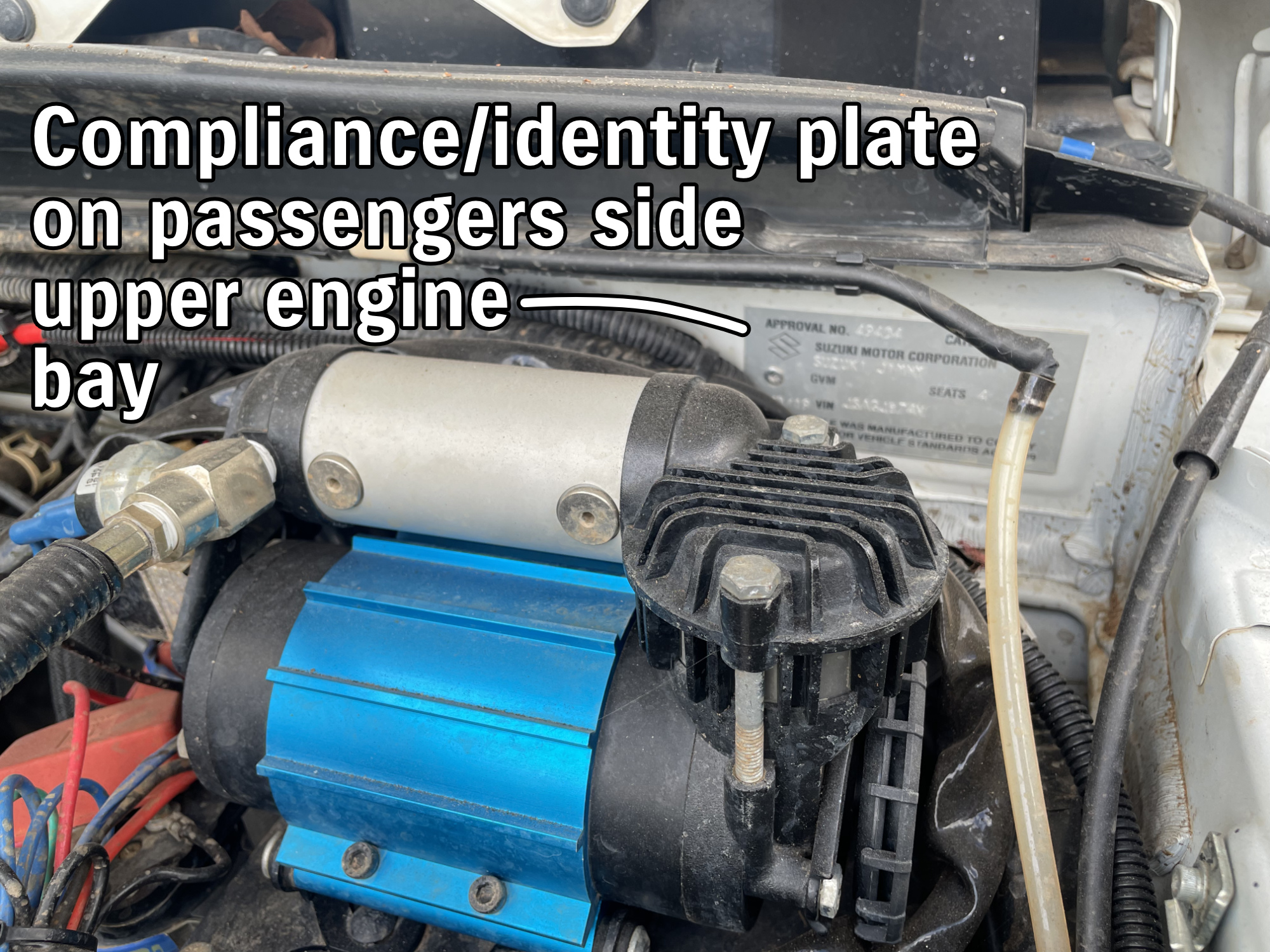
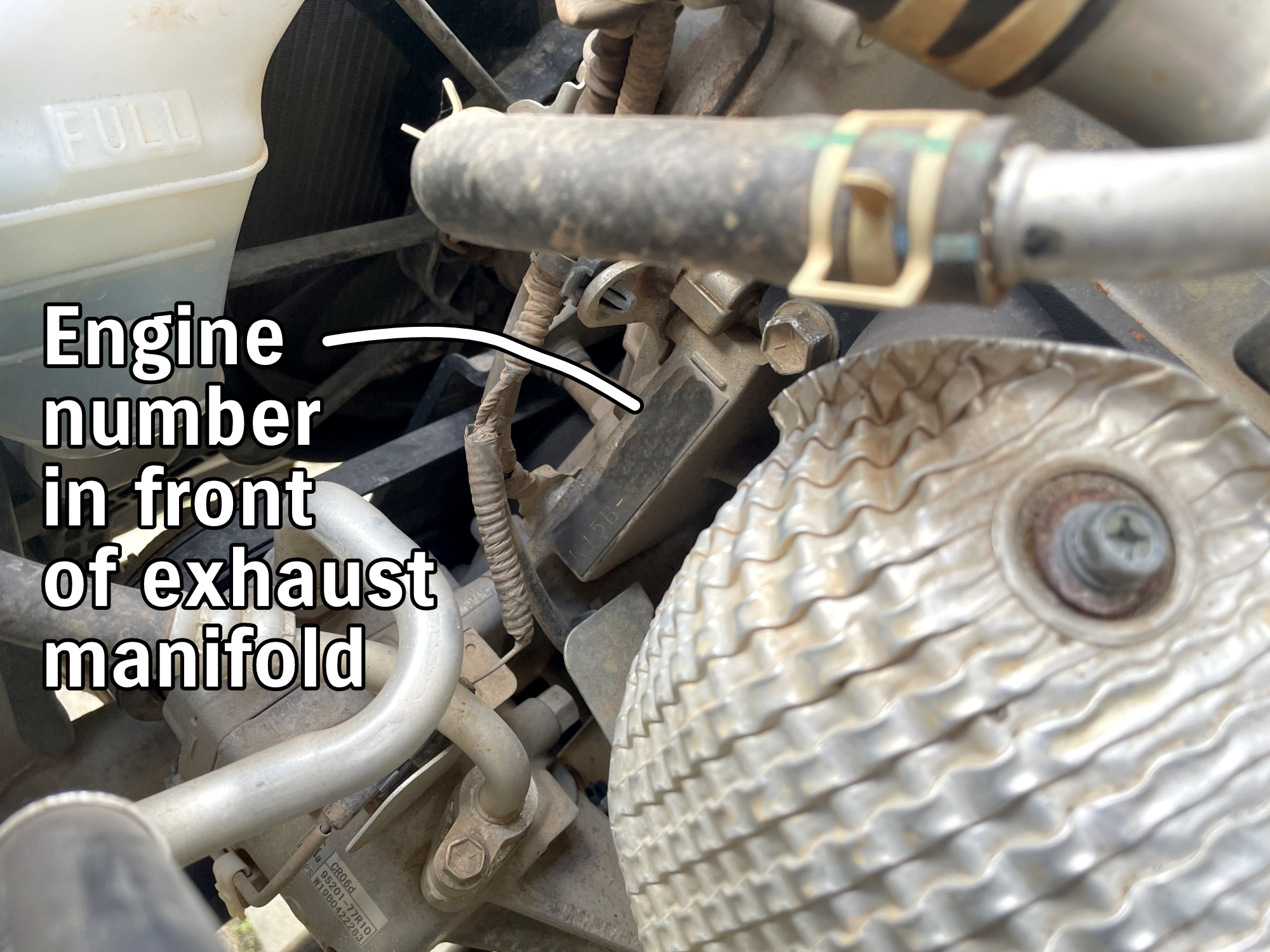
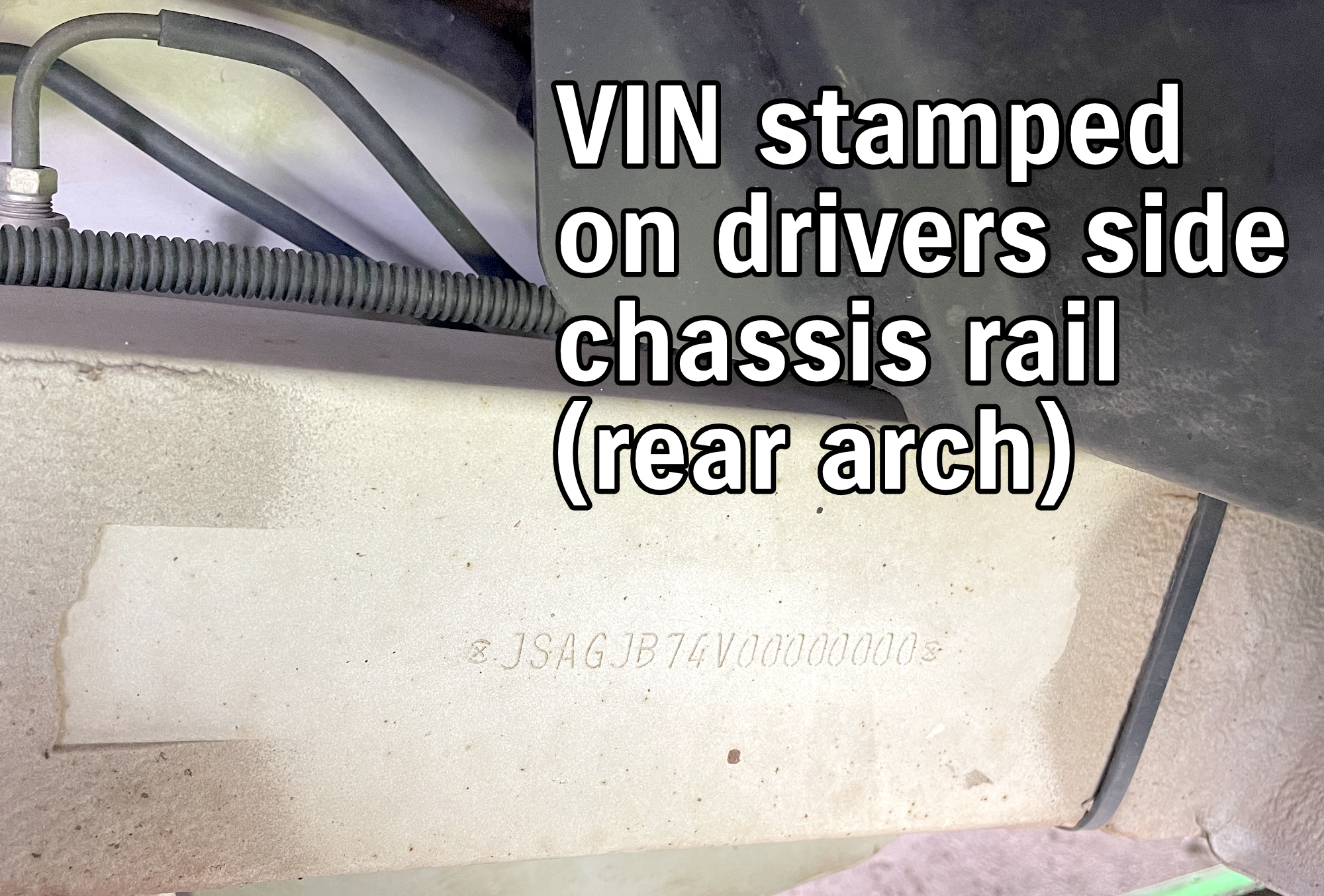
You can also see the VIN in doing a check of any fault codes through a scanner on the OBD2 port, which I would also recommend people do. This is best through szviewer and a compatible device, but a lot of even generic OBD2 scanners will give you the odometer and VIN registered in the ECU.
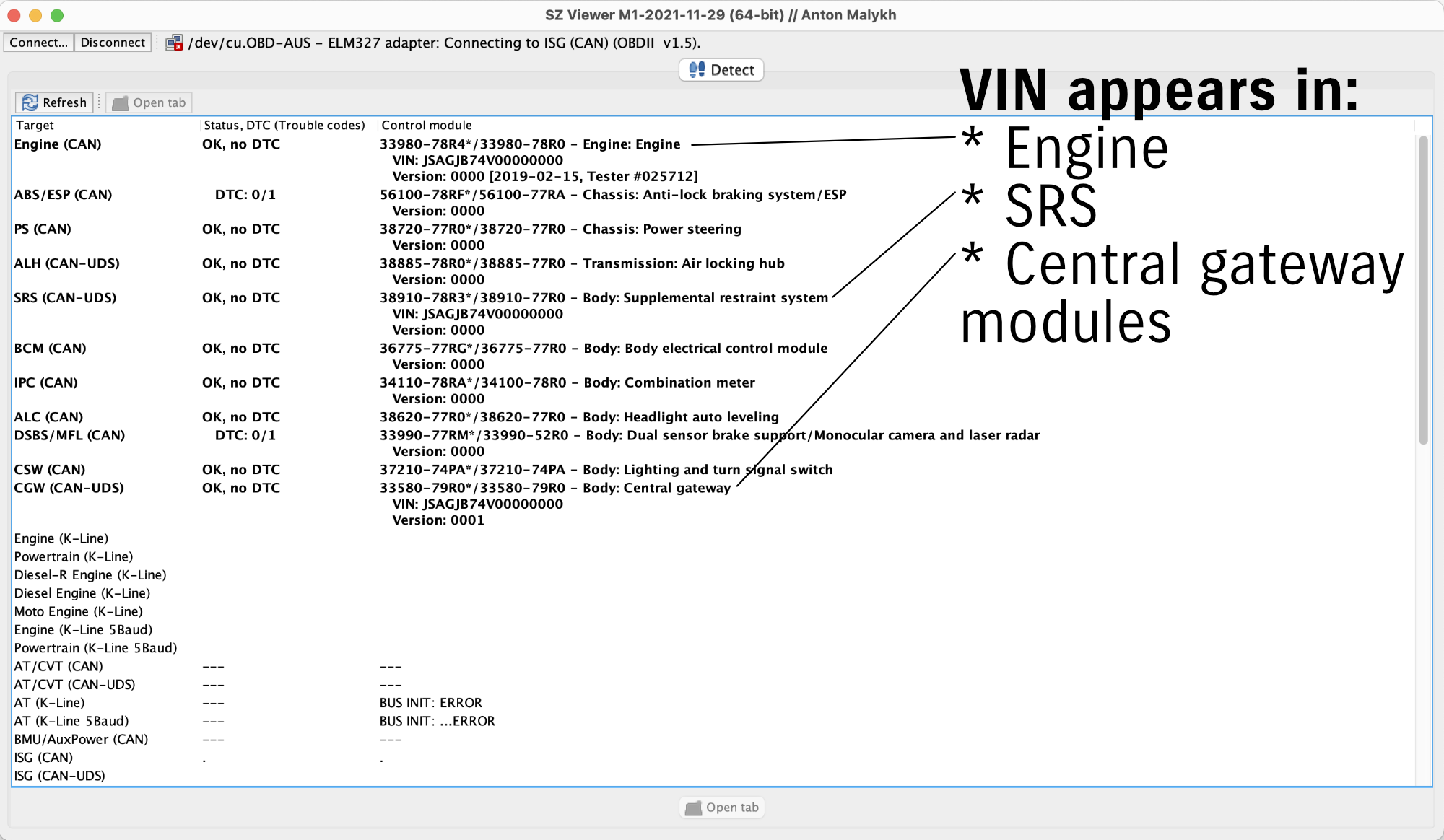
You should also OBD2 scan any car you drive. Even if there’s no check engine lights, still scan modules to look for pending codes and at least write down what they are if any. In relation to check engine lights: the lights should light up when you put the key on before you start the car, but after starting the car they should all go out within 5-10 seconds and no errors should show on the dashboard. If they don’t show up when the ignition is on then it’s possible someone’s changed things (e.g. snipped power to the globe!) to hide a problem. Trust no-one selling any vehicle.
Tyres
First thing I’d check on any walk around on a prospective car are the tyres. You should be looking here at if the tyre brands and size match on all 4 corners plus the spare, and also the tread depth on all tyres. I also like to check tyre pressures: Tyre pressure can also be a great indicator of how well someone’s looked after the car. While this phrase will spark a debate, even larger tyres should be run around the stock pressures of 26 psi (180 kPa) front and 26 to 29 psi (200 kPa) rear. Another thing to look for but often ignored would be the date code on the tyre: this will be a 4 digit code, the first 2 of which are the week # of the year, and the last 2 are the year that the tyre was produced. As an example from some tyres I have run here’s examples of where some of this info can be found on the sidewalls.
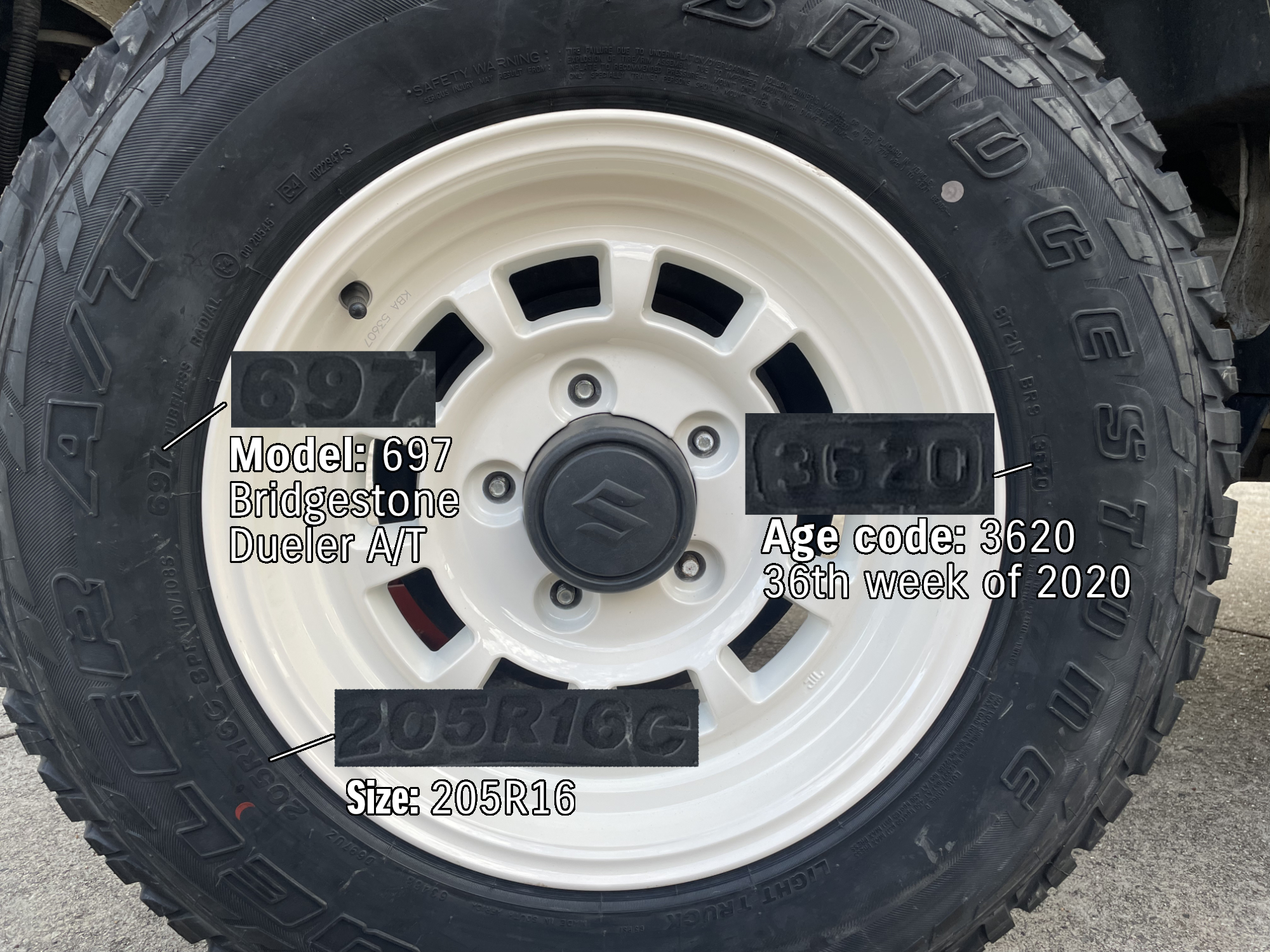
Note that stock wheels are 15″ diameter, and stock tyres are 195/80-15 highway terrain, either Bridgestone or Dunlop branded depending on age of the car and phase of the moon when it was shipped to Australia. Stock wheels are alloys for a 3 door GLX or 5 door XL, and steel wheels for a lite.
Ride height
Another thing to check once you get to a car, even just visually, are the ride heights. On a 4wd I measure ride heights to see if the claim of what lift has been fitted to a car is in it. Even just measuring the passengers side (less likely to sag) is a good way to put truth to claims made. Jimnys (unloaded) should have a little rake with the front lower than the back.
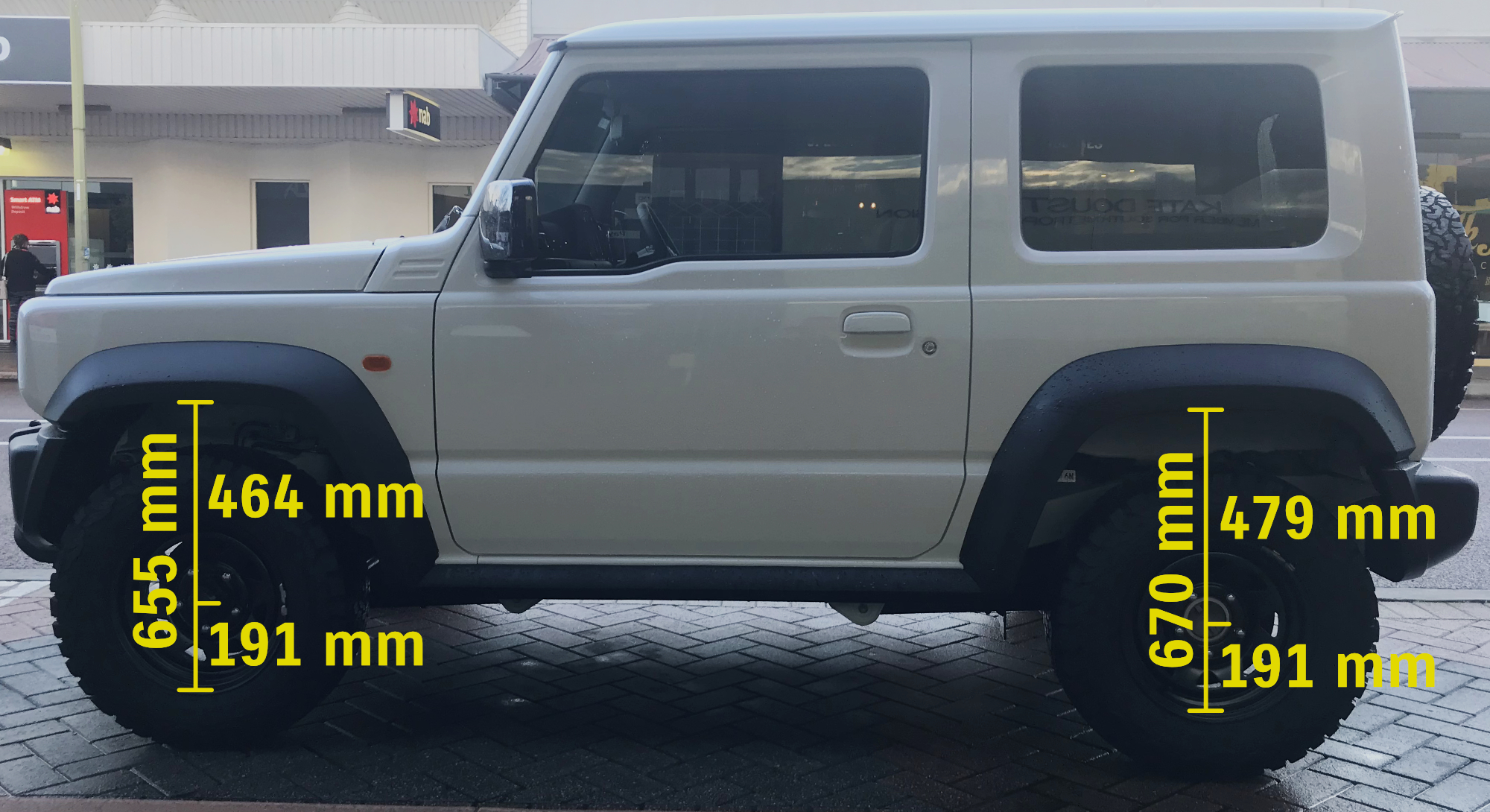
Underbody
In addition to the suspension ride heights, it’s good to cast your eye over the suspension underneath. You want to look for shocks with signs of leakage, and potentially damage/rust/corrosion to springs. This is a good time to note if it has modified suspension which we’ll get into more detail on later. Another thing to check here are the condition of all ball joints e.g. on the ends of the anti-roll bar, and the steering tie rod.
Radius arm mount damage is incredibly common on Jimnys as the radius arm cups are particularly vulnerable to underbody damage, so look to see if there are any scrapes or folded over radius arm mounts underneath the car. This isn’t a deal breaker, but if someone’s saying their car has never been offroad and the radius arm mounts are completely thrashed then that’s a sign that they’re not telling the truth. And if they’re not telling the truth on that then what else might they be a little misleading on?
Other underbody damage also should be scrutinised. Scrapes are ok, but not if they deform things or pull off the undercoating and expose fresh metal. Plus, once again, if someone says it’s never been offroad and there’s a huge scrape there then what have they been doing in the Coles carpark?
Some surface rust is inevitable, even on undercoated cars. You want to look for signs of obvious rust bubbles or areas where the metal is noticeably weak. A good clean underbody is also a sign of someone taking care of a car, though also be careful of overly clean and freshly painted underbodies: that’s a good sign someone’s tarted it up for sale and had something to hide. Ideally, since it might not be pristine off the showroom floor condition, you want to see ‘honest’ condition: nothing being hidden, and no obvious signs of problems.
While underneath the car it’s a good idea to poke your head at the back of the wheels and look at the amount of brake material left on the front pads and the rear shoes. Shoes are able to be inspected by a rubber inspection cap on the backing plate for the drum; front caliper you look down the back of it to see how much pad material is left.
Potentially this is easier with the wheels off, which is a good time to introduce the concept of a thorough look at the wheel bearings. Jimny rear wheel bearings in particular (but also the fronts) are vulnerable to getting contaminated with water or mud in offroad use, and they also cop a lot of abuse being a short wheel base car. With a wheel jacked up and the handbrake off (for rear wheels), you can wiggle the wheel. Almost no movement should be felt. More than a couple of mm or an obviously clunk and you’re looking at wheel bearing replacements. Leaking from the back of the drums or the swivel hub is also another sign of a problematic bearing needing attention soon.
The other oil leak areas to look at are the transmission, transfer case, both diffs and the driveshaft joints (especially the rubber boot over the CV joint at the back of the transfer case to the rear propshaft). Usually transmission/transfer/diff leaks are down to the fill or drain points not being properly sealed or seated, but as stated diff leaks at the ends of the axles can be a sign of bearing troubles. The rubber boot on the rear propshaft is known to split, and formally requires replacing the entire propshaft. If it’s split and spitting grease then you definitely need to address it.
Manual vehicles can be prone to leaking slave cylinders on the side of the gearbox. They are vulnerable to mud/dirt getting into the seal. Once they start leaking then they provide clutch troubles as then the clutch won’t fully disengage the engine from the gearbox when the clutch pedal is pushed.
Engine bay
Moving to the engine bay the first thing you should look for are oil leaks (or other fluid leaks). I always check every fluid level, including the windscreen washer bottle: another good sign of someone paying attention to their car. Check underneath the oil cap for any milky residue. Good practise here would also be seeing if the radiator hoses are warm to the touch: if someone is hiding a car that doesn’t start well cold then they might have pre-warmed the car up before you got there. Be suspicious!
While I don’t check oil levels of things that require me to open them up (e.g. diffs, transmission, transfer), at least the Jimny’s auto provides a dip stick so definitely check that. Note that there’s also no power steering fluid to check, unlike older cars, as the power steering is all electric in a gen4 Jimny.
4wds do like to see dirty roads and I always check air filter condition on a 4wd, even if it was supposedly recently replaced. While I don’t expect it to be pristine, if it’s filthy and clogged then that’s also something you’d want to replace when you get the car too.
The brake fluid level is a good thing to check, especially if you noted any leaking out of the clutch slave cylinder on a manual vehicle. The brake and clutch fluid are shared, and while it won’t stop you having brakes, losing fluid is not a good time.
Paint chips/flaking paint
This is a common Jimny complaint, especially for MY2021 cars and beyond (as processes changed throughout covid). Black roofs are especially evident as the paint can chip off and in the worst case it can flake off a bit. This wouldn’t necessarily put me off a car totally and it is something you might see on a lot of Jimnys – but you should at least make sure that it’s superficial damage and not leading to deeper problems like consistent rust or similar.
Body damage
A lot of 4wds get used (way more than are listed “never taken offroad”), and with that use comes the risk of body damage. Look for obvious things like dents or paint scrapes, but also there’s less obvious things: bumpers or trim or wheel arch extensions not fitting correctly is a sign of other damage. Checking paint in different lights to see if areas have been repainted is another good thing to do in order to decipher the history of a vehicle you might buy. Things like wheel arch bolts where the bonnet line meets the guard can give you a sign of if panels have been re-aligned: look for marks where the bolts might have been previously to get clues about this.
Lights/horns exterior things working
Always take the time to check lights are working as expected. This is everything: park lights, fog lights (if fitted), indicators including the side repeaters, brake and tail lights etc. Note that you need to be aware of the gen4 Jimny’s automatic headlights. You need the car to be running, and ideally just put the headlights into the manual mode on the end of the light stalk so you can check high beam as well as low beam. On GLX and XL models, the fog lights in the bumper also include the DRL bulbs that are on when the headlights are not on but the car is running. Make sure both the DRL bulbs and the fog light bulbs work if both are fitted (lites do not have fog lights).
While the Jimny’s horn is a little pathetic, it definitely should work and toot in a cheeky fashion. This can be a common thing that gets water/mud in it offroad and may not totally work and it’s an easy way to fail a roadworthy.
Wiper blades should be checked while you’re looking at things outside the car. Blade rubber should be new and fresh looking, and not cracked. The windscreen washer, when periodically activated with the headlights on, will also wash the headlights on models with LED headlights (GLX and XL models). This can also be manually activated by the headlight washing switch in the controls by the driver’s right knee.
Interior
Seat foam, especially drivers base, is prone to potentially degrading. Check how firm the seats feel and also for signs of small white ‘fluff’ underneath the seat which shows the foam is starting to come apart. Also look for obvious fabric damage on the seat itself; and if the car has seat covers then remove them to check the condition of the seat fabric.
You should definitely check the climate control or heater/A/C controls. Put the fan on maximum and A/C on (lite) or temperature to lowest setting (GLX/XL) and the vents should blow very cold air. Heat control to maximum (lite) or temperature to highest setting (GLX/XL) and the vents, on the other hand, should blow warm air once the car has been driven and the engine has warmed up. Verify both states to make sure everything is ok with it.
Infotainment systems definitely need to be tested as they are a fundamental part of modern cars. The USB port should at least let you connect your phone to infotainment systems that support it; radio should work and GPS mode should work on the 7″ screens on GLX models that are not MY22 cars. This is also a good time to try to see if an aftermarket infotainment system has been installed, and that all the functions work if they have. This includes verifying steering wheel controls work with the stereo system.
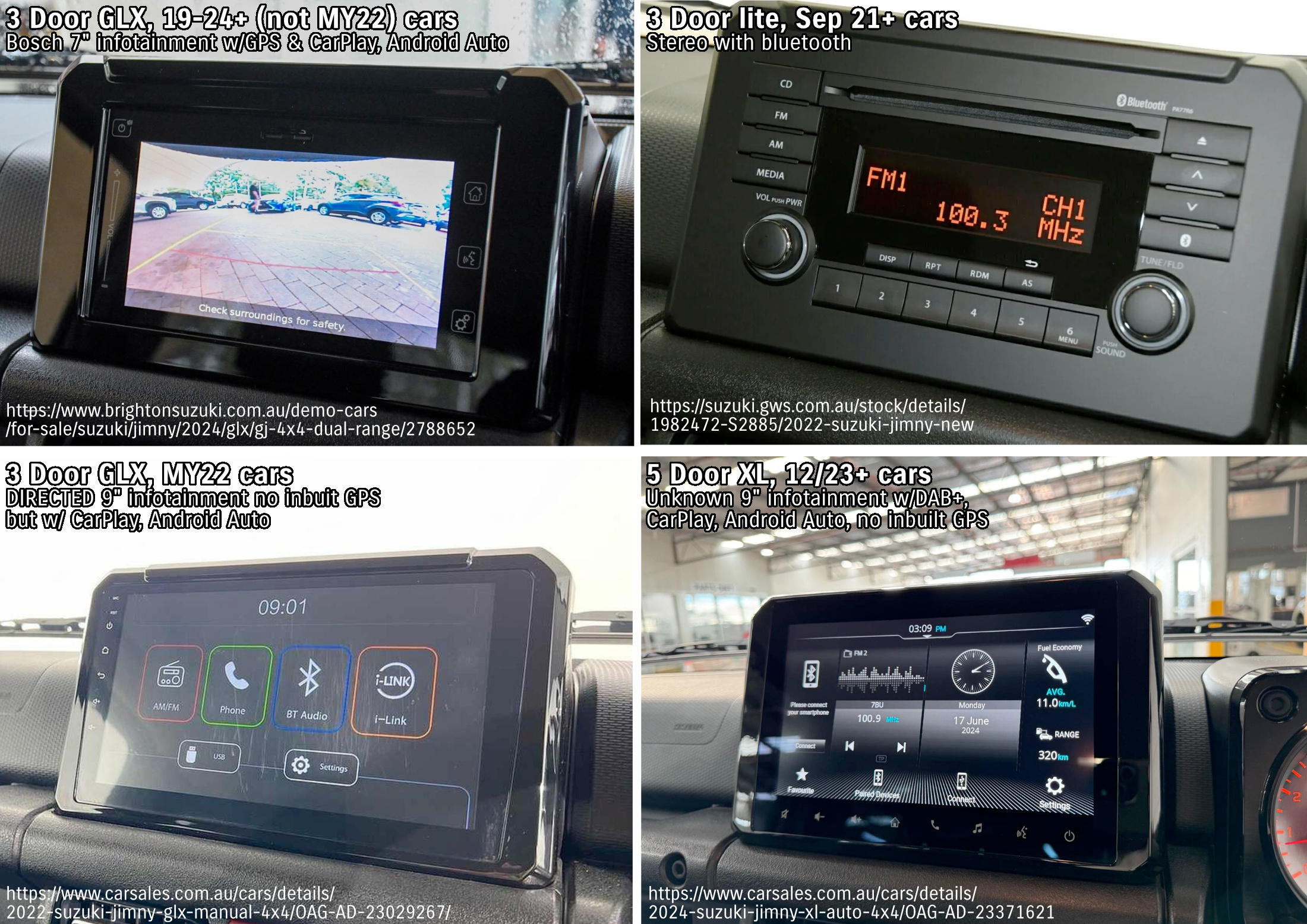
A final thing I’d check is for any damage on seat belts. Pull them all the way out and make sure there’s no fraying or nicks in the seatbelt material. If the car has had rear seats removed, you also want to make sure that the rear seatbelts are retained as that can cause issues with the airbag/seatbelt pretensioner system. If the previous owner has deleted them and turned off the warning light then you would want to get your hands on the seatbelts.
Another thing commonly removed from the cars is the rear luggage box in 3 door cars, especially if a false floor has been fitted. All Australian 3 doors came with the luggage box originally, and while it isn’t expensive to replace it is worth having.
If you pop this luggage box out (it just clips in), then lift up the carpet flap beneath it (if it’s still present – I’ve lost mine!) you will find the tools and jack for the car. You should also verify that these are here; it sucks to get a flat on the drive home with a new car and discover you have no tools to fit the spare tyre.
Service history
Ideally you will get some indication of the service history of the vehicle. This can be as simple as a service sticker on the windscreen showing when the car was last serviced, through to stamps in the owners service handbook or even better invoices from all services/work performed.
If someone says they have serviced the car themselves, I’d want to see some invoices for the sorts of parts they buy for it & check that against things like what oil filter is on the car and similar things. I trust myself to work on my car but backyard people are such a wide spectrum and often things can be missed that end up adding up to be large issues.
Note that should the services be performed by any registered mechanic using OEM parts or their equivalents then the car will have an easier time with any warranty claims you have. Warranties are 3 years/100,000 for cars delivered before October 2019 (with some caveats taking it up to 5 years/140,000 km), and 5 years/160,00 km for cars delivered October 2019 onwards. Factory warranty transfers to any subsequent buyers, though any extended dealership based warranties purchased by other owners usually do not transfer to new owners.
If the car has been serviced under Suzuki’s capped price servicing program then this service program also can transfer to a new owner. If capped price services are missed then a new owner can get back onto this schedule but usually dealership charge a fee to ‘catch up’ the servicing to where it should be first.
Other clues about its life
A great clue about the history of the car is where it’s got an instagram/tiktok/youtube handle on the window, then go on that platform and check out the car in action. It also can be worth searching for the owner’s name in the various FB groups, and also looking through media files on various FB groups if it has a custom plate to make it more distinctive. This is even more easily done for modified cars – the combination of modifications can make it easier to spot a unique car out of all of the other cars out there, and you can get a good sense of the history of the car doing some basic research.
On a test drive
Transfer case noise taking off in first (manuals)
Something to note is that almost all (manual) Jimnys have a little noise taking off in first gear. This comes from the transfer case chain and some resonance in it. It’s most apparent at ~2000 rpm and either coming off the throttle then back on it, or loaded up as you take off. A gentle takeoff and it probably won’t make noise; more revs and more clutch slipping by you and it probably won’t make it either. It’s hard to describe, but it is just a known thing. If it’s just a minor graunch noise on takeoff then it’s probably ok, if it is persistent or does it at more revs/more gears/more load combinations then it could be a sign of an excessively worn transfer case chain.
Some were fixed under warranty with revised part numbers but the noise generally remains, and it doesn’t seem to do any harm.
Note that some cars with reduction gears will also stretch the chain (probably from slightly incorrectly ground/sized teeth on the reduction gearing set). Since the chain is also always driven and used even in 2wd high range, cars that have seen lots of load might also excessively wear the chain and thus make more noise from the transfer case.
Other noises: what’s normal versus not normal?
Again this is hard to explain in text form, but the Jimny has very little sound deadening from the factory and you will hear a lot more driveline and road noise compared to a lot of (modern) cars. Ideally you need to drive a couple to get a feel for what is normal, but you can certainly expect to hear gear and bearing noise especially in low gears.
Note that in the manuals 5th gear is 1:1 ratio, and 3rd gear in the autos is 1:1 so you get the least driveline noise in those gears. This can be a good way to isolate gearbox noise from the rest of the road noise.
Steering play/feel
A common comment by new Jimny drivers is around the steering feel of the car. Given it runs a worm-drive steering box rather than a rack and pinion style rack, there is always some degree of steering play in the car. Excessive play is > 30 mm movement at the edge of the steering wheel (call it about 5º). This can be taken up with adjustment in the steering box if there is play everywhere, but note that you need to make sure the steering doesn’t bind at the ends of the travel (there will always be more wear in the middle versus the end of the steering travel).
In addition to this, the Jimny is boxed shaped with archaic suspension. If it is on stock suspension and tyres in particular you might find the car does not always track particularly straight and/or will be blown around by crosswinds. That’s one of the drawbacks to it as a car and something to consider. The factory rear suspension at least tends to pack down and jump around a bit; upgraded suspension usually drives a lot nicer.
Modified cars (discussed more below) may have worse straight-ahead tracking depending on the amount of suspension lift applied and what’s been done (if any) around correcting the caster. If you find the car picks a direction you last slightly pointed it in and goes in that direction then that’s a sign of poor caster.
People also seem to excessively inflate Jimny tyres and this has an adverse effect on their steering and handling, especially as it promotes the car jumping around more. 26 psi front and rear is a good starting point: it’s a light car with little baggy tyres, it doesn’t need the 40+ psi people seem to think all 4wds need just because their Dad’s LandCruiser did in the 1980s.
Handbrake: correctly adjusted?
Something I’ve noticed in a few cars I’ve driven is that the handbrakes are often incorrectly adjusted. The handbrake shouldn’t drag with 1 click, but it should engage fully and hold the car with around 6-7 clicks of pull only. A non-functional handbrake could well be one of the first signs of rear wheel bearings (discussed below) that are on their way out. Handbrake adjustment should be completed at services, and it doesn’t take long but does require taking the centre console out (3 plastic rivet pins). Not everyone dilligently does that and then you end up with a handbrake that even LandCruiser 79 series owners would embarrased by.
Steering wobbles, especially around 60-70 km/h
This is mostly something you see in higher km cars and/or is based a bit on how 3rd generation cars aged. Live axle cars have pretty basic suspension and the Jimny is no exception. Steering wobbles aka the ‘death wobbles’ can occur and these are often felt in the 60-70 km/h range, but I’d try to test a car all the way up to highway speed at a few steady speeds.
It can be quite easy for some wear in things like the kingpin bearings or steering components to induce quite significant wobbles into the steering. Another area this can happen is with modified suspension cars that haven’t been set up right: done well a 2-3″ lifted car should drive well and basically feel ‘normal’ but it’s very possible for people to do things wrong and end up with a car that wobbles.
This can also come about with people swapping in replacement wheels. Jimny wheels are barely hubcentric on the front and they aren’t at all on the back, so people need to take care centering the wheels when they tighten them down. You see this mostly with aftermarket steel wheels but you can also get it with aluminium wheels. If a wheel shop hasn’t taken care to fit the wheels then off centre wheels can give you horrific steering shake, and, potentially you’ll never fully rectify it if they’ve wound the wheel nuts down hard into the wheels. It is often mistaken for incorrect wheel balance, but it can be as simple as wheels slightly off centre.
Excessively wide, high offset wheels (say in the -20 and more negative range) can also induce steering wobbles. This comes about as offset changes will affect the ‘scrub radius’ of the car, and going highly negative on the offset can induce steering wobbles when driving in a straight line.
Wheel bearings
This is one of the key areas to keep an eye on, especially with Jimnys used offroad hard (especially in mud). The wheel bearings, in particular the rears, are very vulnerable to getting contamination in them and they can fail quickly. Short wheel base cars are also hard on their wheel bearings, especially when people load them up as you can very easily end up offroad with just 1 rear wheel on the ground: that bearing is then taking all of the load of the car which does shorten its lifespan.
The best way to check these is to jack the car up and feel for play in the bearing. There will be a small amount of movement for a bearing that is fine (specification is 0.7 mm in-out movement of the axle with the wheel and brake assembly removed), but, excessive movement means a wheel bearing that needs replacement.
Since these are solid axle cars, wheel bearing replacement is taking the brake off, pulling the axle out, cutting off the old bearing and ABS ring and pressing on a new one. This can be up to $600 a side for bearing and labour depending on the shop who does it, though experienced places can do it much faster.
Cars that have been looked after can still have this as an issue, depending on how much mud and muck has made its way into the wheel bearings offroad. Even just water crossings with the axles a bit warn can be enough to suck in moisture sufficient to cause issues with wheel bearings, so definitely look at cars that have been used more extensively offroad very carefully. It’s not a huge problem to change the bearings, but something to budget for with an older car that’s seen some use.
Modified? Things to look for with common mods
If you’d like to think about what modifications you might want to do to your prospective car, and maybe that’ll help narrow down what car to buy, then I have gone through and provided my thoughts on some recommended modifications for the gen4 Jimny.
Suspension lifts
First off with suspension lifts is to see if it has a ‘pre registration GVM upgrade‘. This is an upgrade applied by taking the car through a second-stage manufacturer process with a lift. Ironman have had one available since September 2020, Tough Dog since 2023 and TJM since 2024. This is currently only applicable to 3 door cars. If they have had a pre-rego GVM upgrade, then the ‘type approval’ of the car will be:
- Ironman: 1785 kg GVM, type approval # 50688, manufacturer “IRONMAN 4X4 PTY LTD”
- Tough Dog: 1800 kg GVM, type approval # 61893, manufacturer “4 WAY SUSPENSION PRODUCTS PTY LTD”
- TJM: 1800 kg GVM, type approval # 63560, manufacturer “AEROKLAS ASIA PACIFIC GROUP PTY LTD”
This is in contrast to the Suzuki type approval for the 3 door which is # 49434.
Until 1 July 2021, cars had to be fitted with a ‘compliance plate, and by mid 2022 these plates were pahsed out. A pre-rego GVM car may have an additional ‘second stage manufacturer’ compliance plate with the type number shown here, but it can also just be entered into the compliance database. Generally this is something you can check through the registration paperwork for the car – just look for those type approvals numbers and/or manufacturer details. You can also (in theory) search the VIN in the register of approved vehicles, however, I’ve found that it is inconsistent for vehicles entered prior to 2023. As an example, here is a car from early 2024 with a second-stage manufacturer approved GVM upgrade applied to it as per RAVS.
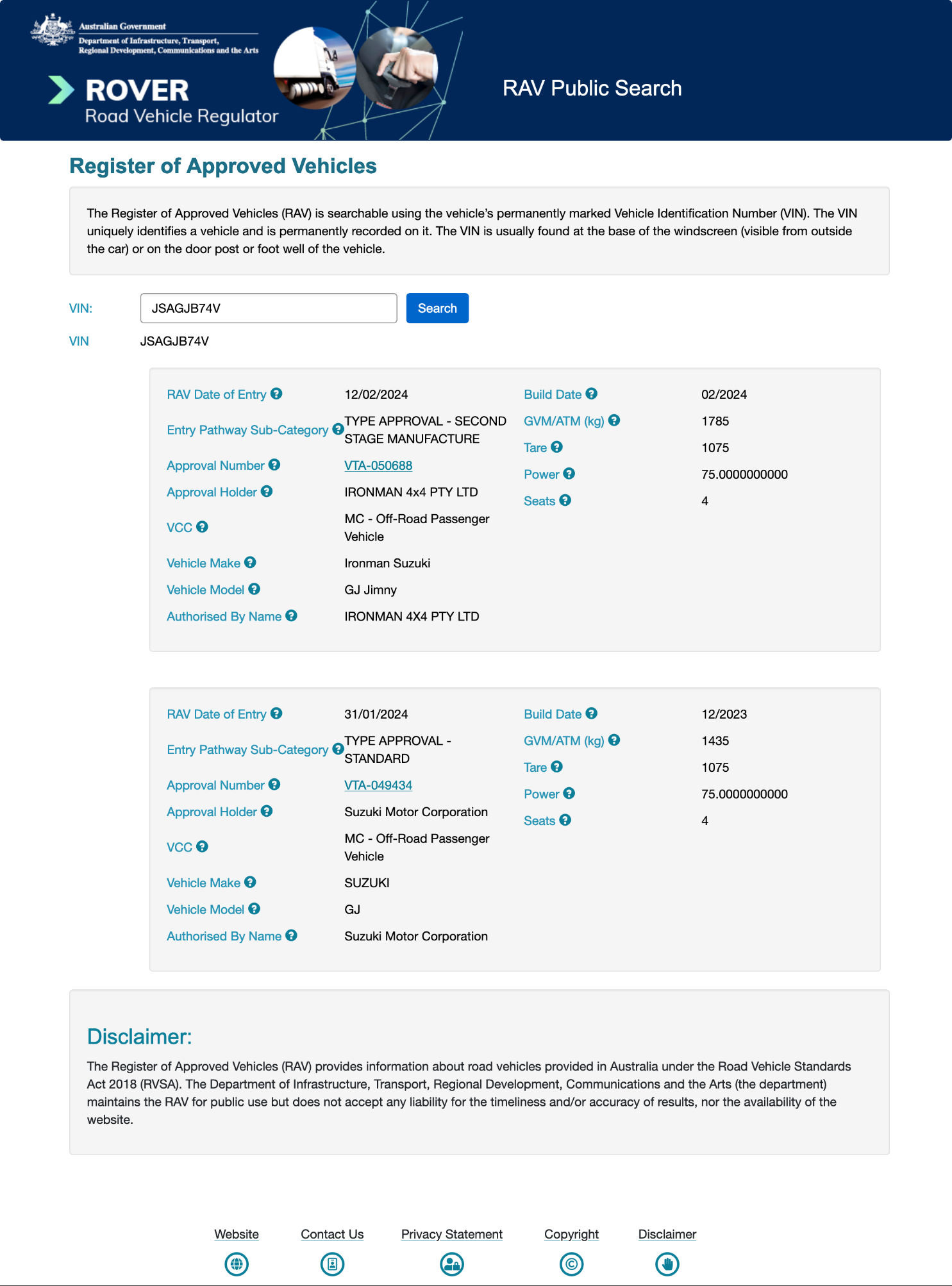
If the car has a GVM upgrade but it is approved post rego, it will have a ‘mod plate’ mounted to the car instead. This will be down to the issuing state as to what it is and what it says. Nothing wrong per se with a state mod plate, however, if you are buying the car to have in another state then you will have to a) get the paperwork from the time it was originally installed and b) take the car through an engineering/modplate process in the new state. This is an additional expensive (~$600-$900) that is not required for a pre-rego GVM upgraded car. You can also get caught out that some states will only allow the GVM upgrade if the car is otherwise totally standard e.g. standard wheels and tyres, so you need to be ready for that scenario, too.
It’s also possible to have a suspension lift and no GVM upgrade. Again, no problem at all; the GVM upgrade is something to get only if you are absolutely exceeding the GVM. There are other good quality suspension lifts that are not GVM upgrades, and in fact I recommend them for a lot of people.
Verifying what lift is installed
The first and biggest clue is to look at the shock absorbers for brands or stickers, or even colours. OME/ARB shocks are yellow usually with prominent OLD MAN EMU branding; Ironman are white with quite a lime green colour (and lime green springs) and the Dobinsons springs are a teal colour. Tough Dog shocks are silver with their yellow sticker, and they have a yellow to gold spring colour. I have not compiled an exhaustive list for Jimny lift kits, but the following figure will cover about 98% of all lifted Jimnys you find on sale in Australia. The other 2% will be more specialised combinations or some other aspect. This is especially useful to help weed out people who might claim they have a GVM upgrade installed but don’t have one of the lifts that can be fitted as a GVM upgrade.
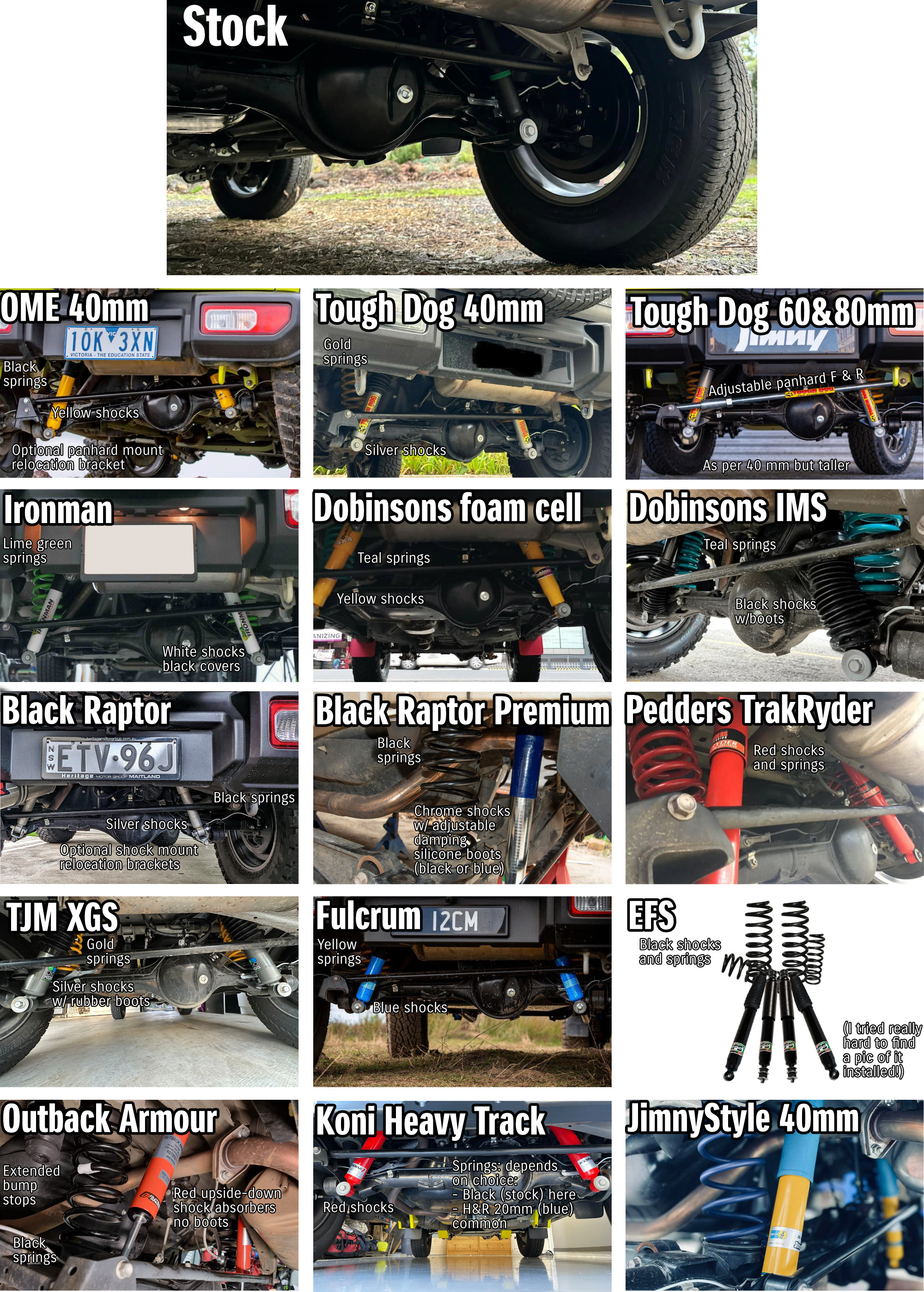
Lift height is easiest verified by measuring from the middle of the bottom rim lip up to the highest opening in the guard, as mentioned in the what to check section above.
Measuring in this way removes the effect of any larger than standard tyre if you were to measure from the ground, and it’s a slightly easier datum to . Assuming 15″ wheels, the following measurements apply from this point:
| Lift height | Front | Rear |
|---|---|---|
| Stock | 655 | 670 |
| 20mm | 675 | 690 |
| 40mm | 695 | 710 |
| 50mm / 2″ | 705 | 720 |
| 60mm | 715 | 730 |
| 80mm | 735 | 750 |
| 100 mm / 4″ | 755 | 770 |
There are a couple of things that might have been overlooked with a suspension lift. First off, if the car is a 3 door GLX and has LED headlights then it has a headlight levelling sensor which attaches to the rear axle (lites don’t have self levelling headlights, and, 5 doors are manually levelled using a dial on the switches by the driver). There is a replacement bracket needed for this: it either replaces the factory arm or spaces the sensor down. If this isn’t done you’ll probably see the sensor is bent or ripped down, or otherwise mangled.
Lifts that are more than 45mm need to consider both longer front brake lines and also replacing or spacing down the 3rd crossmember as otherwise the front propshaft will hit the crossmember at full suspension droop. If the car is a largeish lift then it is worth checking that the brake lines have been replaced. You can spot this if they’re braided metal brake lines, or if they have different manufacturer markings on them, or even just looking to see if there’s signs that the bolts and nuts have been taken off and put back on again (i.e. with some marks on the edges of the corners of the bolt).
Replacement wheels and tyres (and side note on reduction gearing)
It’s quite common for people to replace tyres on offroad cars, but especially Jimnys. We’ve already gone through how to look at some of the features of the tyres and wheels that might be fitted.
Replacement wheels could be steel or alloy; it’s worth understanding what has been fitted as they both have their pros and cons. It’s good to look at brand names and see if it’s a quality brand or something that’s less well known. The trick here is that some of the very fancy and expensive Japanese wheels might sound like a no-name brand, but actually they’re very good. Best to do some research on the wheels based on things like Facebook group posts from other people who have fitted them.
There is a small note with replaced wheels: unless the centre bore is 108mm through the wheel, the stock rear centre caps will not fit on the wheels. This means you can potentially see the end of the axle, which is also prone to rusting and looking pretty average. The rust isn’t bad, mostly just unsightly, but just something to bear in mind for aesthetics. The front ‘caps’ are not just caps, they are the actual 4wd hubs to engage 4wd, so that’s why you only notice missing centre caps on the rear wheels.
With changed tyres you should look at what size they are quite critically: The larger the tyres the more ground clearance the car has under the axles, but, the slower it will accelerate due to the effectively longer gearing. Here’s a comparison of some of the common Jimny tyre size changes and how different they are to standard.
| Size label | Lift under axle | Gearing change | Legal? | Caveats |
|---|---|---|---|---|
| Stock (195/80-15) | 0 mm | 0% | Yes | |
| 215/75-15 | 6 mm | 1.5% | Yes | |
| 235/75-15 | 21 mm | 5.9% | Yes | Potentially with wider wheels for full legality; May need bumper trimming; WA/SA/NT/Tas lift < 30 mm |
| 205R16 | 21 mm | 5.9% | Yes | (Needs 16″ rims); May need bumper trimming; WA/SA/NT/Tas lift < 30 mm |
| 30/9.5-15 | 35 mm | 9.9% | No (unless engineered) | Might need reduction gears |
| 31/9.5-15 | 47 mm | 13.6% | No (unless engineered) | Possibly needs reduction gears |
| 235/85-16 | 56 mm | 16.1% | No (unless engineered) | Really should have reduction gears |
It’s also worth considering the tyres that are fitted on the car. Mud terrain tyres look great and perform excellently in many offroad conditions, but might be overkill on the daily commute, noisier, use more fuel, and potentially not as good in sand situations as less aggressive tyres. On the flipside, if the car is on highway terrain tyres and you want to do large offroad things then you might be looking to upgrade the tyres sooner rather than later.
As noted in the table above, it potentially is something where gearing can be affected significantly. While there are no external ways to check, there are ways to change the gearing of the car which is a useful thing for when you fit much larger wheels. If the car has unknown ‘reduction gears’ in it, then you want to look at the relationship between revs and speed as measured on a GPS/phone app that uses GPS. Drive in top gear on the highway, and get to 100 km/h on the GPS. Ignore what the speedo says! While I’ve given precise RPM values, these are hard to read off the analogue tacho but might be accessible via an OBD2 reader. This will help you deduce the high range reduction.
| RPM @ 100 km/h, MT/AT | 0% reduction | 6% reduction | 10% | 15% | 17% |
|---|---|---|---|---|---|
| 195/80-15 (0%) | 3131 / 3029 | 3319 / 3211 | 3444 / 3332 | 3601 / 3483 | 3663 / 3544 |
| 215/75-15 (1.5%) | 3085 / 2984 | 3270 / 3163 | 3393 / 3283 | 3547 / 3432 | 3609 / 3492 |
| 235/75-15/205R16 (5.9%) | 2957 / 2860 | 3134 / 3032 | 3252 / 3146 | 3400 / 3289 | 3459 / 3346 |
| 30/9.5-15 (9.9%) | 2849 / 2756 | 3020 / 2922 | 3134 / 3032 | 3276 / 3170 | 3333 / 3225 |
| 31/9.5-15 (13.6%) | 2756 / 2666 | 2922 / 2826 | 3032 / 2933 | 3170 / 3066 | 3225 / 3120 |
| 235/85-16 (16.1%) | 2697 / 2609 | 2859 / 2765 | 2966 / 2870 | 3101 / 3000 | 3155 / 3052 |
Low range reduction is harder to suss out, but narrowing down the high range reduction helps if someone’s modified the transfer case gearing. Standard transfer gearing is twice as slow in low range for a given gear & rpm, so the easiest test if you have low range reduction in a car is to see a speed for a given RPM in a given gear in high range. If the same gear and RPM gives exactly half the speed then you have standard low range gearing, if it is much slower than half speed then you have low range reduction installed.
Bullbars/replacement bumpers
Pretty common to see replacement bumpers and/or bullbars on Jimnys. There’s probably almost as many to catalogue as there are suspension upgrades. Some main considerations are:
a) What brand is it?
b) Is it ADR comliant (this involves testing for compatibility around crash structures and also airbag use; some aspects around wheel covering and stuff also comes into it and could be an issue come roadworthy time)
c) Is it too heavy for your needs?
A key reason for that last point is that bullbars can vary in weight significantly. Fully looped bullbars end up adding about 35 to nearly 60 kg to the car depending on the bullbar brand; loopless bumper replacements will be a little lighter than that but still relatively heavy. If you get a car with a bullbar and you aren’t interested in keeping it then it’s not always straightforwards to put a stock bumper back on. That said, front bumpers are readily available free or cheaply so there are options if you want to do this and the car doesn’t come with the standard parts.
Bullbars aren’t essential to fitting a winch (can buy hidden winch plates) or driving lights (can buy light mounts that work with the stock bumper e.g. the IPF light mount works well and is quite rigid). Also note that they are no guarantee of full protection against animal strikes: modern bullbars do need to protect pedestrians as part of the design rules so it is possible to still end up with some minor panel damage (though potentially less than if you didn’t have one).
Driving lights
While on the topic of things at the front, one area that catches people out are driving lights. On cars with the LED headlights you need 6 pin plugs to make up piggyback connectors. Some 4wd shops will just use basic scotchlocks or similar to tap into the wiring; this makes issues harder to sort out but also harder if you want to remove the driving lights into the future.
To be fully legal, driving lights need to only work with the high beam of the car and need a separate on-off switch to disable them separately to the high beam. Note that if you want to test this then you need to make sure the car is in headlights on mode, not headlights in auto mode. If you’re in auto mode then headlight stalk forward for high beam is automatic high beam; turn the end of the stalk all the way to ON instead and now you have manual control over the high beam to test the lights.
Seat covers
Seat covers are a contentious topic, mostly because good ones are quite expensive and people don’t always want to pay that. The problem is that the Jimny has airbags in its seats (like many modern cars). These are an integrated component of the crashworthiness of the car.
Seat covers have the potential to interfere with the deployment of these airbags, and so you need to make sure any seat covers fitted will work with the airbags correctly. In general, generic seat covers are much less likely to work well, and good Australian made ones (e.g. SupaFit or Black Duck) with fully certified seams are quite expensive. (I’d say they are worth it, though, especially because an airbag inflating inside your seat cover is not a fun time in the middle of an accident you probably already didn’t want to have).
Larger fuel tank
The Jimny has a small fuel tank standard (40L: the fuel light comes on with about 10L remaining!). There are a couple of options for replacement fuel tanks but the main one is the 80L full tank replacement from The Long Ranger. These are a great addition to the car, but there’s a couple of things you want to check out if they are fitted:
a) Who fitted it?
It can be self installed or have a shop install it. Self installs, assuming the car is running, probably won’t have any problems however you might have issues when it comes time for registration transfer if an inspection is involved. Upgraded tanks are a modification that does need to be reported to the relevant road/traffic authority in your State, and this paperwork might become your problem if it wasn’t already done when the install was made. Usually professional shops will have done this paperwork at the time of install.
b) Does it all work as intended?
This is really something you gauge by quizzing the existing owner (if you can – harder at a car yard). The Long Ranger modifications include modifying the fuel level sender so the gauge works as intended and changes linearly. You’ll want to find out if this is the case by just asking how it works with the owner. (Note that the distance to empty can’t be adjusted, so you have to mentally double the distance to empty for a fuel tank like the Long Ranger which is double the capacity).
Some auxiliary tanks (e.g. the Brown & Davis 30L rear sub tank) have a separate fuel pump to transfer to the main tank, and you want to verify that this works as intended. No good having 30L extra in a 2nd tank if it won’t transfer!
Exhaust modifications
Related to the installation of larger or auxiliary fuel tanks is the need to modify the exhaust. People also modify the exhausts on Jimnys as they can be a good way to unlock a little more power (and noise). Auxiliary or larger tanks usually need rerouting the exhaust.
The key things here to look at are the following points:
- What brand?
- How well does it fit, e.g. when you wobble it around does it clank on things?
- Does it maintain both catalysts if it’s a full exhaust system?
The latter point can be important. While there are hacks to get around the emissions checks, ultimately a lot of people with deleted cats (even if just 1 of the 2) and things like spacing the oxygen sensor out of the exhaust flow to fool check engine lights, these are often not foolproof things. Given that codes can take a while to trigger check engine lights, it’s more than possible for sellers to reset any check engine lights so all is good on a test drive, but a couple of trips after you’ve bought the car and suddenly it’s popped a check engine light for catalyst performance or similar. This is why it’s important to scan modern cars for any relevant pending codes.
Interior changes
Another common area of Jimny modifications are changes to the interior. There’s probably too many things to really list them here, but a big one would be false floors or drawers in the back. You want to see if the seats have been removed, and if they have if the owner still has the originals. This can be an area of annoyance getting through a roadworthy inspection when you buy the car. Seatbelts are best preserved in the case of a 2 seat conversion as otherwise you’ll get airbag warning lights from the lack of pretensioners on the back circuit of the safety systems.
Another area that can be commonly done are modifications with the addition of sound deadening. This is very hard to verify without pulling the carpet, but it can make a good difference to the comfort of the car on long distances. That said, some people go overboard with the amount of heavy sound deadening they add (there are diminishing returns) and so can also have added a lot of extra weight (potentially 12-25 kg extra) which can cut down on your maximum payload.
Openable back windows
It is possible to replace the rear windows on the 3 door Jimnys for openable windows, either gullwings or sliding windows. I’ve done it, and it’s probably my favourite modification I made to the car. You should examine the windows to see how well they’ve been installed, and also if they’re to your liking: some of the cheaper brands have relatively flimsy locking mechanisms so can present a risk around security of the vehicle.
Good to also look for any signs of water ingress from the windows; again I’ve seen some of the cheaper brands leak, plus leaks can come from improper installation by glaziers who didn’t take the time to clean up the factory sealant. Paint damage might also have occurred around the window frame, too; this isn’t a huge problem if it is touched up (since it’s not very obvious till you look up close) but unpainted damage can be a weak spot for rust to form from.
